Common Procedures
Topics on this page

Regular Exams and Cleanings
Regular exams are an important part of maintaining your child's oral health. During your child’s regular exam, we will:
- Check for any problems that may not be seen or felt
- Look for cavities or any other signs of tooth decay
- Inspect the teeth and gums for gingivitis and signs of periodontal disease
- Perform a thorough teeth cleaning
Your child’s exam will take about 45 minutes. Each regular exam includes a detailed teeth cleaning, in which we will clean, polish, and rinse the teeth to remove any tartar and plaque that have built up on the tooth’s surface.
Visiting our office every six months gives you the chance to talk to the doctor about any questions you may have about your child’s oral health. Regular exams are offered by appointment only, so please contact our practice today to schedule your child’s next dental exam and teeth cleaning.
Fluoride
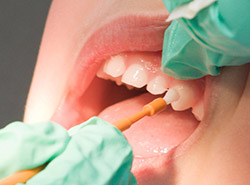 Fluoride is effective in preventing cavities and tooth decay and in preventing plaque from building up and hardening on the tooth’s surface. A fluoride treatment in a dentist’s office takes just a few seconds. We typically use a fluoride varnish which leaves a sticky film on the teeth for several hours after it's application. Patients can eat and drink right away and are asked to refrain from brushing and flossing for 4-6 hours to allow for absorption of the fluoride by the enamel surface. Depending on your child’s oral health, risk of decay or decay present the doctor will make a proper recommendtion on frequency of fluoride application.
Fluoride is effective in preventing cavities and tooth decay and in preventing plaque from building up and hardening on the tooth’s surface. A fluoride treatment in a dentist’s office takes just a few seconds. We typically use a fluoride varnish which leaves a sticky film on the teeth for several hours after it's application. Patients can eat and drink right away and are asked to refrain from brushing and flossing for 4-6 hours to allow for absorption of the fluoride by the enamel surface. Depending on your child’s oral health, risk of decay or decay present the doctor will make a proper recommendtion on frequency of fluoride application.
Sealants
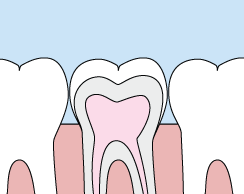 Sometimes brushing is not enough, especially when it comes to those hard-to-reach spots in your child’s mouth. It is difficult for a toothbrush to get in between the small cracks and grooves on your child’s teeth. If left alone, those tiny areas can develop tooth decay. Sealants give your child’s teeth extra protection against decay and help prevent cavities.
Sometimes brushing is not enough, especially when it comes to those hard-to-reach spots in your child’s mouth. It is difficult for a toothbrush to get in between the small cracks and grooves on your child’s teeth. If left alone, those tiny areas can develop tooth decay. Sealants give your child’s teeth extra protection against decay and help prevent cavities.
Dental sealants are a plastic resin that bonds and hardens in the deep grooves on your child’s tooth’s surface. When a tooth is sealed, the tiny grooves become smooth and are less likely to harbor plaque. With sealants, brushing your child's teeth becomes easier and more effective against tooth decay.
Sealants are typically applied to children’s teeth as a preventive measure against tooth decay after the permanent teeth have erupted. It is more common to seal “permanent” teeth rather than “baby” teeth, but every patient has unique needs, and your child’s dentist will recommend sealants on a case-by-case basis.
Sealants last from three to five years, but it is fairly common to see adults with sealants still intact from their childhood. A dental sealant only provides protection when it is fully intact, so if your child’s sealants come off, let your dentist know, and schedule an appointment for your child's teeth to be re-sealed.
Fillings
 If your child has a cavity which needs to be filled have no fear!! We typically use composite resin ("white fillings) to restore teeth, as it enables us to preserve healthy tooth structure surrounding the decayed areas. Parents usually prefer the white fillings because of their cosmetic appearance. We fill teeth for children the same way that adults have their teeth filled but we talk about the procedure in a "child friendly" manner so as to keep our patients from being anxious about it. If needed we utilize nitrous oxide ("laughing gas") and local anesthesia ("novocaine") to make our patients more comfortable.
If your child has a cavity which needs to be filled have no fear!! We typically use composite resin ("white fillings) to restore teeth, as it enables us to preserve healthy tooth structure surrounding the decayed areas. Parents usually prefer the white fillings because of their cosmetic appearance. We fill teeth for children the same way that adults have their teeth filled but we talk about the procedure in a "child friendly" manner so as to keep our patients from being anxious about it. If needed we utilize nitrous oxide ("laughing gas") and local anesthesia ("novocaine") to make our patients more comfortable.
Extractions
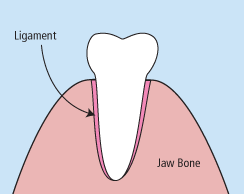 There are times when it is necessary to remove a tooth. Sometimes a baby tooth has misshapen or long roots that prevent it from falling out as it should, and the tooth must be removed to make way for the permanent tooth to erupt. At other times, a tooth may have so much decay that it puts the surrounding teeth at risk of decay, so the doctor may recommend its removal. Infection, orthodontic correction, or problems with a wisdom tooth can also require removal of a tooth.
There are times when it is necessary to remove a tooth. Sometimes a baby tooth has misshapen or long roots that prevent it from falling out as it should, and the tooth must be removed to make way for the permanent tooth to erupt. At other times, a tooth may have so much decay that it puts the surrounding teeth at risk of decay, so the doctor may recommend its removal. Infection, orthodontic correction, or problems with a wisdom tooth can also require removal of a tooth.
When it is determined that a tooth needs to be removed, your child’s dentist may extract the tooth during a regular checkup or may request another visit for this procedure. Extracting baby teeth is much simpler than removing permanent teeth and we are extremely experienced with performing this procedure. If we determine that it would be better for your child to have the tooth or teeth removed by an oral surgeon we will make that recommendation and point you in the right direction with an excellent referral.
Bonding
 Bonding is a conservative way to repair slightly chipped, discolored, or crooked teeth. During dental bonding, a white filling is placed onto your child's tooth to improve its appearance. The filling “bonds” with the tooth, and because it comes in a variety of tooth-colored shades, it closely matches the appearance of your child's natural teeth.
Bonding is a conservative way to repair slightly chipped, discolored, or crooked teeth. During dental bonding, a white filling is placed onto your child's tooth to improve its appearance. The filling “bonds” with the tooth, and because it comes in a variety of tooth-colored shades, it closely matches the appearance of your child's natural teeth.
Tooth bonding can also be used for fillings instead of amalgam (silver filling). Many patients prefer bonded fillings because the white color is much less noticeable than silver. Bonding fillings can be used on front or back teeth, depending on the location and extent of tooth decay.
Bonding is less expensive than other cosmetic treatments and can usually be completed in one visit to our office. However, bonding can stain and is easier to break than other cosmetic treatments, such as porcelain veneers. If it does break or chip, tell your doctor. The bonding can generally be easily patched or repaired in one visit.
Mouthguards
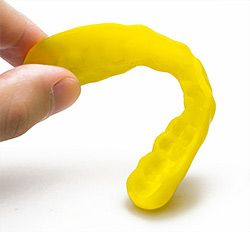 Whether your child wears braces or not, protecting his or her smile while playing sports is essential. Mouthguards help protect the teeth and gums from injury. If your child participates in any kind of full-contact sport, the American Dental Association recommends that he or she wear a mouthguard. Choosing the right mouthguard is essential. There are three basic types of mouthguards: the pre-made mouthguard, the “boil-and-bite” fitted mouthguard, and a custom-made mouthguard from the dentist. When you choose a mouthguard, be sure to pick one that is tear-resistant, comfortable and well-fitted for your mouth, easy to keep clean, and does not prevent your child from breathing properly. Your dentist can show your child how to wear a mouthguard properly and how to choose the right mouthguard to protect his or her smile.
Whether your child wears braces or not, protecting his or her smile while playing sports is essential. Mouthguards help protect the teeth and gums from injury. If your child participates in any kind of full-contact sport, the American Dental Association recommends that he or she wear a mouthguard. Choosing the right mouthguard is essential. There are three basic types of mouthguards: the pre-made mouthguard, the “boil-and-bite” fitted mouthguard, and a custom-made mouthguard from the dentist. When you choose a mouthguard, be sure to pick one that is tear-resistant, comfortable and well-fitted for your mouth, easy to keep clean, and does not prevent your child from breathing properly. Your dentist can show your child how to wear a mouthguard properly and how to choose the right mouthguard to protect his or her smile.
Nightguards
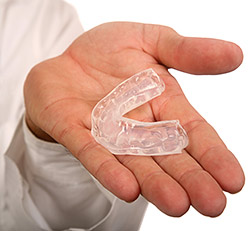 If your child often wakes up with jaw pain, earaches, or headaches, or if you see your child clenching or grinding his or her teeth, your child may have a common condition called “bruxism”. Many people do not even know that they grind their teeth, as it often occurs when one is sleeping. If not corrected, bruxism can lead to broken teeth, cracked teeth, or even tooth loss.
If your child often wakes up with jaw pain, earaches, or headaches, or if you see your child clenching or grinding his or her teeth, your child may have a common condition called “bruxism”. Many people do not even know that they grind their teeth, as it often occurs when one is sleeping. If not corrected, bruxism can lead to broken teeth, cracked teeth, or even tooth loss.
There is an easy, non-invasive treatment for bruxism: nightguards. Nightguards are an easy way to prevent the wear and damage that teeth-grinding causes over time. Custom-made by a dentist from soft material to fit the teeth, a nightguard is inserted over your child’s top or bottom arch and prevents contact with the opposing teeth.



 Website Powered by Sesame 24-7™
Website Powered by Sesame 24-7™